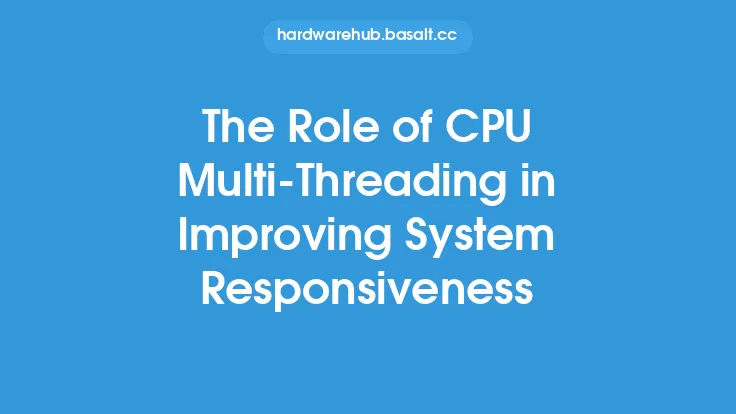The concept of CPU multi-threading has revolutionized the way we approach resource-intensive applications, enabling computers to handle multiple tasks simultaneously with greater efficiency. At its core, CPU multi-threading is a technique that allows a single processor to execute multiple threads or flows of execution concurrently, improving overall system performance and responsiveness. This is achieved by leveraging the processor's ability to switch between threads quickly, minimizing idle time and maximizing throughput.
Introduction to CPU Multi-Threading
CPU multi-threading is made possible by the processor's ability to execute multiple instruction streams simultaneously. This is achieved through the use of multiple processing units, such as cores or threads, which can execute instructions independently. Each core or thread can handle a separate task or thread, allowing the processor to handle multiple tasks concurrently. The key to CPU multi-threading is the ability to switch between threads quickly, minimizing the overhead associated with context switching. This is achieved through the use of advanced scheduling algorithms and hardware-based thread management techniques.
Architecture and Implementation
The architecture and implementation of CPU multi-threading vary depending on the specific processor design. In general, modern processors use a combination of hardware and software techniques to implement multi-threading. At the hardware level, processors use multiple execution units, such as cores or threads, to execute instructions concurrently. Each execution unit is capable of executing a separate instruction stream, allowing the processor to handle multiple tasks simultaneously. The software layer provides the necessary scheduling and thread management algorithms to manage the execution of multiple threads. This includes techniques such as thread scheduling, context switching, and synchronization.
Scheduling and Thread Management
Scheduling and thread management are critical components of CPU multi-threading. The scheduler is responsible for allocating threads to available execution units, ensuring that each thread is executed efficiently and effectively. The scheduler must also manage context switching, which involves saving and restoring the state of each thread as it is switched in and out of execution. This is a complex task, as it requires minimizing the overhead associated with context switching while ensuring that each thread is executed fairly and efficiently. Advanced scheduling algorithms, such as priority scheduling and round-robin scheduling, are used to manage thread execution and ensure that each thread is allocated sufficient resources.
Benefits of CPU Multi-Threading in Resource-Intensive Applications
CPU multi-threading offers several benefits in resource-intensive applications, including improved performance, increased throughput, and enhanced responsiveness. By executing multiple threads concurrently, processors can handle complex tasks more efficiently, reducing the time required to complete each task. This is particularly important in applications such as video editing, 3D modeling, and scientific simulations, where multiple tasks must be executed simultaneously. Additionally, CPU multi-threading enables processors to handle multiple tasks concurrently, improving overall system responsiveness and reducing the likelihood of system crashes or freezes.
Technical Details and Optimizations
From a technical perspective, CPU multi-threading involves several optimizations and techniques to improve performance and efficiency. One key technique is pipelining, which involves breaking down complex instructions into simpler, more manageable tasks. This allows the processor to execute instructions more efficiently, reducing the overhead associated with instruction execution. Another technique is cache optimization, which involves optimizing the use of cache memory to reduce the time required to access main memory. This is critical in multi-threaded applications, where multiple threads may be accessing shared data simultaneously. Additionally, processors use techniques such as speculative execution and out-of-order execution to improve instruction-level parallelism and reduce the overhead associated with instruction execution.
Real-World Applications and Use Cases
CPU multi-threading has numerous real-world applications and use cases, including video editing, 3D modeling, scientific simulations, and data analytics. In video editing, for example, CPU multi-threading enables processors to handle multiple tasks concurrently, such as video encoding, color correction, and audio processing. This improves overall system performance and responsiveness, reducing the time required to complete complex video editing tasks. Similarly, in scientific simulations, CPU multi-threading enables processors to handle complex calculations concurrently, reducing the time required to complete simulations and improving overall system performance.
Conclusion and Future Directions
In conclusion, CPU multi-threading is a critical technique for improving performance and responsiveness in resource-intensive applications. By executing multiple threads concurrently, processors can handle complex tasks more efficiently, reducing the time required to complete each task. As processor designs continue to evolve, we can expect to see further improvements in CPU multi-threading, including the use of advanced scheduling algorithms, hardware-based thread management techniques, and optimized cache memory architectures. Additionally, the increasing use of multi-core and many-core processors will continue to drive the development of CPU multi-threading, enabling computers to handle increasingly complex tasks with greater efficiency and effectiveness.





